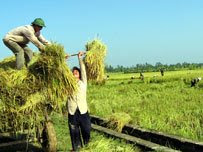 VietNamNet Bridge – Corruption in ODA-funded projects is unacceptable, the counsellor of the Swedish Embassy in Vietnam, Molly Lien, told VietNamNet ahead of the anti-corruption dialogue between international donors and the Vietnamese government tomorrow, November 28.
VietNamNet Bridge – Corruption in ODA-funded projects is unacceptable, the counsellor of the Swedish Embassy in Vietnam, Molly Lien, told VietNamNet ahead of the anti-corruption dialogue between international donors and the Vietnamese government tomorrow, November 28.
What do you think about the suspension of Huynh Ngoc Sy, Deputy Director of the HCM City Department of Transportation, for allegedly taking a bribe from a Japanese business in the ODA-funded East-West avenue project?
One should not be considered guilty till investigation is completed and after a fair trial. But if there are criminal doubts associated with that person, the government should make decisions like suspending that person while waiting for investigation results.
At the upcoming anti-corruption dialogue between the Vietnamese government and international donors under the Consultative Group Meeting (CG), will donors mention anti-corruption measures in using ODA?
Corruption in ODA-funded projects is unacceptable. Sweden’s ODA, for example, is tax money paid by each Swedish citizen to the Swedish government. ODA is used to assist other countries like Vietnam to eradicate hunger and reduce poverty, to build a democratic society without corruption.
Donors will always pay attention to and worry if ODA is not used for the above purposes. This issue was discussed at anti-corruption dialogues and CG meetings in the past and it may be discussed again at the upcoming dialogue and CG meeting.
The scandal related to the East West avenue project came from Japanese newspapers. It is said that at the upcoming dialogue, donors will suggest heightening the role of the Vietnamese media in preventing and combating corruption. Why are donors interested in this?
The press is seen as a key factor in the fight against corruption. This is recognised by Vietnam and clearly stated in the Law on Corruption Prevention and the draft national corruption fighting strategy.
We believe that to effectively do its mission, the press must have adequate access to information. The press must be allowed to honestly report every issue, both positive and negative, related to corruption and corruption prevention.
How do Sweden and international donors observe corruption prevention in Vietnam recently?
It is important that corruption fighting agencies have sufficient resources and capability to do their job effectively. The role and responsibility of agencies must be clear. However, corruption supervision and prevention should not be only the mission of specialised agencies, the government, or ministries and local authorities. It is necessary to mobilise the press, social organisations and citizens to become involved in corruption prevention.
The number of corruption cases discovered in 2008 is 14 less than last year, with 379 cases in total. What do you think about this?
We can understand that the number of corruption cases this year has been less than last year but we can also understand that there are many more cases than the above number that are undetected. It is difficult to give a comprehensive comment about the result of a certain period of time. In my opinion, there seems to be a gap between laws and practical actions related to this issue.
I think, to discover more corruption cases, it is necessary to ensure that everybody who works in the public, the private sectors, the press and individuals can widely make public information related to corruption cases that they know of. They must be assured that the agencies that they provide corruption-related information to have the power of action and are ready to process the information.
The Vietnamese government has completed the draft national strategy on corruption prevention to 2020. What do Sweden and the international community expect from this document?
We expect that such a strategy will reflect a corruption fighting model in Vietnam’s practical conditions.
Though I have not read the last draft strategy I hope that when it is approved, the strategy will convey a strong message that Vietnam will not accept corruption anymore even in small cases that affect people’s lives, particularly the poor.
Whatever model the Vietnamese government uses to fight corruption, Sweden and donors always wish to help Vietnam to effectively implement its corruption fighting policy.
The Vietnamese National Assembly suggested designing a law to concretise the United Nations’ regulation on controlling government officials’ assets. What is your viewpoint about this?
In Vietnam, income comes from different sources. Besides salary, government officials have other sources of income which are very difficult to control. There are government officials whose incomes are moderate but they have houses, so the question is, where did the money come from?
Any effort promoting transparency and control of government officials’ incomes is important. However, when issuing any regulation, we need to think about how it will be implemented. It is also important to think about where it should start to be implemented and how.
One of the reasons for corruption is the moral degradation of some government employees. What is your advice to Vietnam to solve this matter?
In Sweden, one of the key factors to diminish corruption is transparency in the government and the public sector to maximally lessen the opportunity for state officials to take bribes.
Vietnam can learn experience of the international community, of neighbouring countries like Singapore. Singapore had a very high corruption rate but today, they have a team of professional and spotless state employees. What is the reason for their success?
Interviewer: Xuan Linh





















